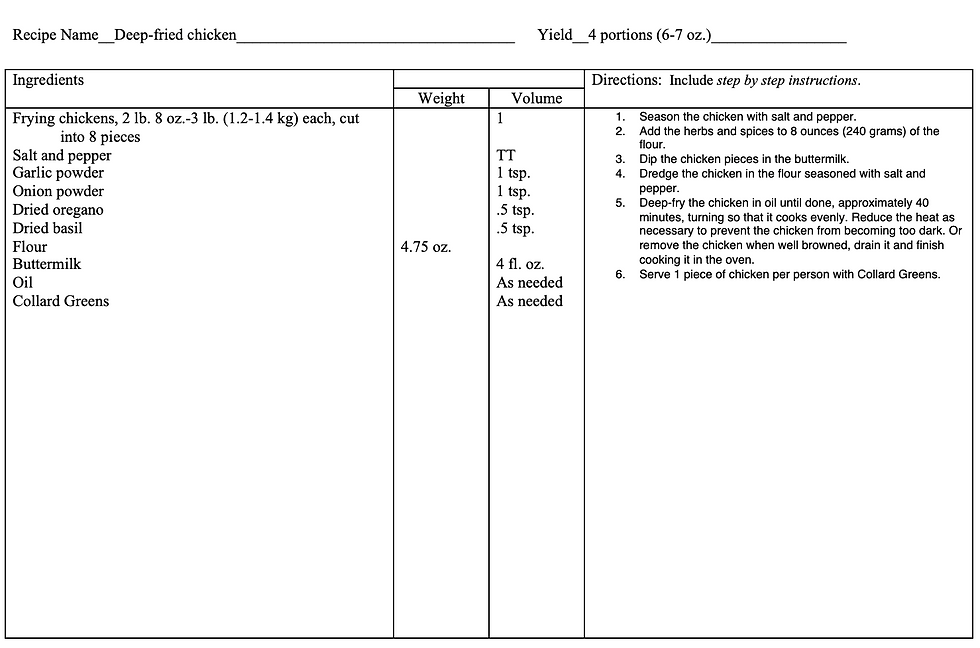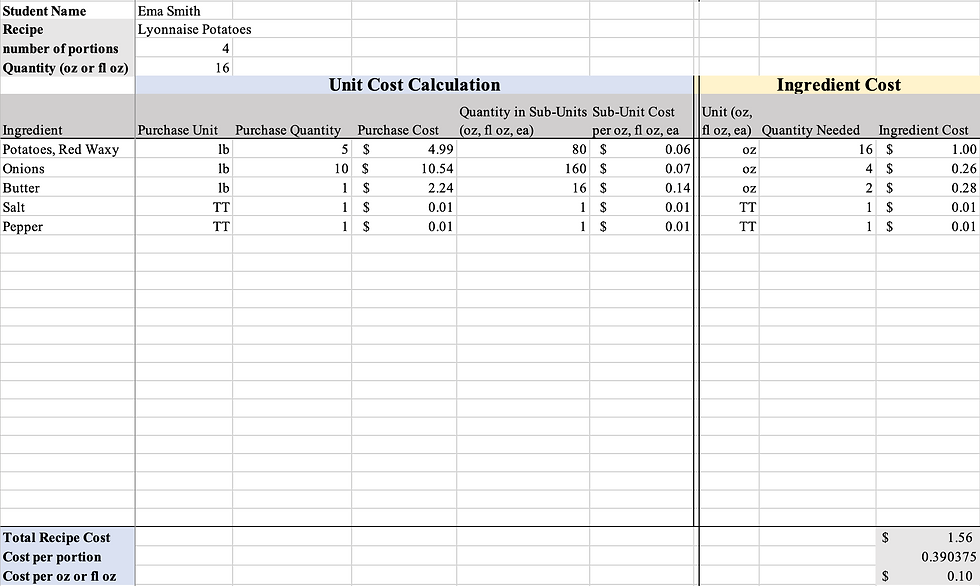Week 6: Frying & Poultry
- ejs0086
- Sep 26, 2023
- 7 min read
Updated: Oct 4, 2023
Research
Introductions
List the method of cookery and dishes to be covered in class
This week, we will use an efficient dry-heat method of cooking meat: deep-frying poultry. This requires a pot that is large enough for the chicken to be submerged completely in hot fat or oil. Our recipe calls for using oil at a temperature between 335 and 375 degrees; this will create a crisp, brown coating after the chicken is dipped in buttermilk and dredged through flour. Another method of frying includes sauteing, which we utilize for the ratatouille. Pots for sauteing must be wide and deep enough to provide an area for stirring and turning food, with enough fat or oil to coat and lubricate the food. Ratatouille involves sauteing onions and garlic in olive oil followed by various vegetables, tomato concassé, spices, and basil. Lyonnaise potatoes must be baked, boiled, or steamed until barely tender before being pan-fried in clarified butter and sauteed with onion.
List your learning objectives for the class
This week, I will try my best to avoid a soggy exterior and aim to produce a crispy breaded deep-fried chicken. Although lyonnaise potatoes are completely different from mashed potatoes, I hope to acquire the right texture and appearance after not meeting this objective in class last week.
Discuss your prior knowledge of the content
I have used a deep-frying method before to make fried oreos, so I am a little familiar with the cooking process. However, deep-frying oreos is extremely easy in comparison to deep-frying chicken because you don't have to worry about the inside being cooked to the correct internal temperature. Deep-frying chicken in class will be more complex than frying a simple cookie.
Background Information
Research and discussion of method of cooking/ techniques
All frying methods are considered dry-heat cooking techniques because rather than using liquids, the food is cooked with fat or oil to produce a browned surface and tender interior. There are four basic frying techniques: sauteing, pan-frying, stir-frying, and deep-frying. We will be deep-frying chicken this week; it is best to use a tender cut of meat for this method, such as chicken or fish, rather than something thick, like a roast. Vegetable oil is an ideal fat for deep-frying because of its neutral flavor and high smoking point. There are two methods of deep-frying: swimming and basket. In the swimming method, food (commonly battered and larger in size than small pieces) is placed gently into a fryer where it sinks to the bottom, then rises to the surface. In the basket method, often used for breaded products such as french fries, food is placed in a mesh basket and lowered into hot fat, then lifted out of the fat when cooking is complete. Ratatouille uses the sauteing method with a small amount of olive oil as a lubricant. Tomatoes are concasséd, having skins and seeds removed before dicing. The food is cooked on high heat and stirred frequently. Lyonnaise potatoes are pan-fried in a small amount of clarified butter, then combined with sauteed onions. The importance of clarifying butter has to do with raising the smoking point temperature. An article published by Eating Well explains that “clarified butter has the richness and flavor of butter, but it can be used for cooking at higher temperatures than regular melted butter since it's the milk solids in butter that tend to scorch” (Ballis, 2023).
Research and discussion of primary ingredient
The primary ingredient for deep-fried chicken is tender chicken cut in pieces small enough to cook thoroughly in the time required to brown and crisp the coating. A Bon Appétit article discusses the best parts of a chicken for deep-frying, stating, “Sure, a fried drumstick may be iconic, but you can fry up the whole bird—including, yep, the breast. In fact, this might be one of the most genius ways to make the best of the breast, which pales in comparison to flavorful legs and thighs” (Bilow, 2014). Ratatouille’s primary ingredient of tomato concassé consists of small diced tomatoes with no seeds or skin. Seeds and skins of tomatoes can be bitter and affect the flavor of the food, so removing them enhances the recipe with more flavor. Not surprisingly, potatoes are the main ingredient for lyonnaise potatoes. Before sauteeing, the potatoes need to be partially cooked by baking, boiling, or steaming until barely tender to the touch. Alone, potatoes are not very flavorful or aromatic, but when sauteed in butter with onions, salt, and pepper, they become a delicious dish.
Dish/method variations
While our recipe calls for deep-fried chicken, we could have used any other types of frying methods - sauteing, pan-frying, or stir-frying. Like deep-frying, pan-frying requires tender meat that is breaded or dipped in batter to produce a browned crust but without using as much oil or fat. Sauteed chicken typically uses smaller cuts of meat that are browned without a crust. Because of the nature of the ingredients in ratatouille (tomato concassé, chopped/diced vegetables, olive oil), sauteeing is the appropriate method of cooking. Lyonnaise potatoes could be sauteed or pan-fried; pan-frying creates a browned and crispier exterior.
Recipes



Plan of Work

Recipe Costing

Report & Reflect

Results
Describe the outcomes of the lab class
The menu this week turned out exceptionally well, with very little struggle throughout the cooking process. My teammate and I successfully made delicious deep-fried chicken, ratatouille, and lyonnaise potatoes. For the main dish, we made two slightly different types of deep-fried chicken using a basket method for both batches. We marinated the first batch of chicken in buttermilk, whereas the second batch was simply dipped in buttermilk before dredging it in seasoned flour. Pictured above is the marinated deep-fried chicken (the first batch), which exhibited a fluffier appearance and texture, and a more flavorful taste than the second batch. Both the ratatouille and lyonnaise potatoes were rich and paired well as side dishes to the deep-fried chicken.
Describe how well the technique/cooking method worked
Deep frying the chicken in a basket was a great cooking method to use for this meal; it was efficient and gave our dish a perfectly cripsy exterior, with a tender interior. Cutting up the chicken was fairly difficult and not very pleasing to do at 8:00 in the morning, but carefuly doing so allowed the meat to cook evenly. Sauteing the ratatouille was the best method to use in terms of flavor, but it was difficult to maintain the bright colors and still achieve the desired soft texture. Furthermore, pan frying the lyonnaise potatoes took longer than expected because each slice must lay flat, and the pan we used could only fit about seven slices (for reference, we had a total of almost 50 potato slices when combined with our other teammates' potatoes). Perhaps the pan frying method would have been more efficient if we had not combined the lyonnaise potatoes.
Describe the sensory results of the dish;
Taste
The deep-fried chicken and lyonnaise potatoes turned out incredibly salty. Nevertheless, each dish on the menu this week exhibited a savory taste, with the ratatouille being outstandingly rich. The first batch of chicken that marinated in buttermilk was saltier and more savory than the second batch because the chicken absorbed more seasoning from the buttermilk and it was coated with seasoned flour.
Flavor
Each dish presented a its own unique, delicious flavor. The marinated deep-fried chicken was savory, tender, and flavorful; you could significantly tell a difference from flavorsome buttermilk. The lyonnaise potatoes presented a rich, buttery flavor with hints of onion and warm aromas. Adding chives to the potatoes would have enhanced the warm aromas even further. The ratatouille was very rich from the large slices of tomato concassee that we decided not to dice; the chef complimented us on our decision and agreed that it added a richer flavor to the ratatouille.
Texture
The deep-fried chicken had the perfect texture; the meat was moist and tender, and the breading was just the right amount of crispy. Some of the lyonnaise potatoes could have been cooked slightly longer to soften more, while other slices were the ideal texture. We sautéed the onions until they were completely soft, so they wouldn't take away from the buttery flavor or desired texture of the potatoes. The texture of the ratatouille was difficult to achieve despite each vegetable being evenly diced. Each ingredient in the ratatouille was ideally soft after sautéing, but the color of the zucchini and eggplant had to be sacrificed to achieve the preferred texture.
Appearance
I am extremely proud of my plate presentaiton this week. The chef noticed me struggling to be creative and offered to help strengthen the appearance of my meal. The original idea I had started with (the white plate) was lended to my teammate so the Chef could teach me a few pointers about plate presentation. In the end, both plates were visually appealing in their own unique ways. I chose a wooden plate to elevate the elegance of the meal. I included different shapes and heights to add dimension to the plate, along with a red bowl for the ratatouille for a pop of color. Most students used thyme for their dishes, so I decided to be different and garnish the ratatouille with basil, assuring that the tip of the leaves were visible.


Evaluation of results
Explain and discuss the important outcomes using external references and citations;
Discuss the techniques that did work well. Provide an explanation of why they did work.
Deep frying the chicken in a basket gave a perfectly crispy and flavorsome outer shell with a tender inside. Sauteing the ratatouille provided great flavor, but it was hard to maintain the bright colors and texture simultaneously. Pan-frying the lyonnaise potatoes took longer due to limited pan space when we combined a large number of slices from different teammates. Still, the technique worked well and presented rich, savory lyonnaise potatoes.
Discuss the techniques that did not work well. Provide an explanation of why they did work.
All techniques worked very well this week.
Discuss the particular improvements and changes that could be implemented to improve the outcomes
Conclusions
Provide a concise and clear recap of the outcomes of the class.
Discuss the specific learning outcomes of the class and link them to the learning objectives that were previously identified.
Discuss additional skills and knowledge that were learned outside of the previously identified learning objectives.
Explain the potential circumstances that the newly-found skills and knowledge could be applied.
Detail areas that still require practice and improvement.
References
Clarified Butter: What It Is & How to Use It. (Ballis, 2023).
(Bilow, 2014). 7 Fried Chicken Common Mistakes—and How to Avoid Them.



Comments